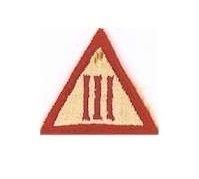Active 1809–2004 Size Brigade | Type Infantry Part of HQ Northern Ireland | |
 | ||
The 3rd Infantry Brigade was a Regular Army infantry brigade of the British Army, part of the 1st Infantry Division. Originally formed in 1809, during the Peninsular War, the brigade had a long history, seeing action in the Second Anglo-Afghan War, and during both World War I and World War II.
Contents
Formation
The 1st Division was formed during the Peninsular War in Spain and Portugal, part of the army commanded by General Arthur Wellesley, later 1st Duke of Wellington. In 1814, the 3rd brigade took part in the Battle of New Orleans, commanded by Lt. Gen. John Keane. It also took part in the Battle of Ali Masjid in November 1878 during the Second Anglo-Afghan War.
First World War
The brigade saw service during the First World War as part of the British Expeditionary Force on the Western Front.
Order of battle
The 3rd Brigade was constituted as follows during the war:
Between the wars
Between the wars the brigade, now redesignated 3rd Infantry Brigade, saw numerous changes in its battalions, including 2nd Bedfordshire and Hertfordshire Regiment, 1st Royal Scots Fusiliers, 1st King's Own Scottish Borderers and 1st Border Regiment. However, these were all posted away by 1937, either to other divisions stationed in the United Kingdom or to different parts of the British Empire. From 1936–1938 the brigade was commanded by Arthur Floyer-Acland In 1938 they were replaced by 2nd Buffs (Royal East Kent Regiment), 2nd Cameronians (Scottish Rifles) and 1st Royal Irish Fusiliers. There was no fourth battalion as it was in this year that British infantry divisions were reduced from twelve to nine battalions, infantry brigades reducing from four to three. These battalions, too, were replaced in early 1939, by 2nd Sherwood Foresters, recently returned from many years spent in British India and Guernsey, 1st Duke of Wellington's Regiment, returned to England from three years spent Malta, and 1st King's Shropshire Light Infantry, which had returned to England in 1938 for the first time after having served in British India in 16 years.
Second World War
During the Second World War the brigade continued to be part of the 1st Infantry Division, and would remain with it throughout the war, and was sent to France on 25 September 1939, shortly after the outbreak of the war, and served as part of the British Expeditionary Force (BEF) in France. The brigade was to remain in France, serving alongside the French Army on the Maginot Line on the Franco-Belgian border until May 1940 when the German Army invaded Holland, Belgium and France and, during the fighting, forced the BEF to retreat to Dunkirk where the 3rd Brigade was evacuated to England, arriving on 1 June 1940.
After the retreat from Dunkirk it remained in the United Kingdom on home defence against a German invasion until early 1943 when it was sent to North Africa to take part in the Campaign in Tunisia. On 11 June 1943 the 1st Infantry Division was sent to the Italian island of Pantelleria (Operation Corkscrew) which they captured and occupied without casualties.
In late 1943 the brigade, with the rest of the division, was sent to Italy to join the British Eighth Army fighting in Italy. However, they were soon transferred to command of the U.S. Fifth Army for the Anzio landings (Operation Shingle), where they landed at Anzio on 22 January 1944 and were destined to fight in some of the worst and most violent battles of the Italian campaign where, during a German counterattack on 3 February, the brigade was almost completely surrounded and was only saved from annihilation by a counterattack from the 1st Battalion, nLondon Scottish of 168th (London) Brigade (temporarily detached from its parent unit, the 56th (London) Infantry Division, to come under 1st Division command). The brigade continued to fight in numerous battles around Anzio and even when not, were still subjected to almost constant artillery, mortar or small arms fire. The brigade fought in the breakout from the Anzio beachhead and Operation Diadem.
In October 1944, while the 3rd Brigade was fighting on the Gothic Line with the Eighth Army, Private Richard Henry Burton of the 1st Battalion, Duke of Wellington's Regiment was awarded the Victoria Cross. In the same battle, Captain Arthur Burns was awarded the Distinguished Service Order. The brigade fought in Italy until 28 January 1945 when they were sent to Palestine as a garrison where they remained to the end of the war.
Order of battle
The 3rd Infantry Brigade was constituted as follows during the war:
Commanders
The following officers commanded 3rd Infantry Brigade during the war:
Post-war
As part of 1st Division the 3rd Brigade was in Egypt after the war until returning to Chiseldon, Wiltshire. During the Suez Crisis the brigade was moved to Malta, in August 1956, from where they went to Egypt on the aircraft carrier HMS Theseus, reaching Port Said just as the ceasefire was declared. It then went on to Cyprus in 1956. Following operations against EOKA, the brigade was disbanded there in 1963.
From 1972, the 3rd Infantry Brigade was headquartered in the Kitchen Hill Factory in Lurgan until moving to the Mahon Road Barracks in Portadown in late 1976, under HQ Northern Ireland and was the HQ element for the security forces which controlled the South Armagh region of Ulster, including several battalions of the Ulster Defence Regiment. In February 1988 the brigade headquarters moved to Drumadd Barracks in Armagh. The brigade was disbanded on 1 September 2004 and its former units divided between 8 Brigade and 39 Brigade.
